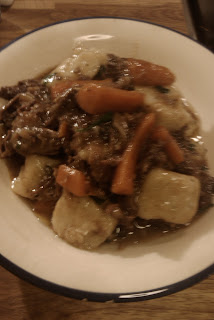Becca has never had chicken pie. Ever. I was shocked, but of course 9 times out of ten, at least, the filling has a creamy sauce and the pastry is made with butter and has an egg glaze, so with her allergies it’s just one of those items on a menu that she just crosses off. Not even worth asking.
It came up because we returned from a weekend away that involved a short trip to the Peak District and a (very) short walk on the fringes of the moors, with a handful of boletus badii, just about enough, as it happened, for a pie. Not chicken, in the end, but guinea fowl, from my favourite butchers, McKanna's aka Theobalds on Theobalds Road. I was sorely tempted by their great range of game birds, but after last week’s pheasant adventures, felt less of an urge to break away from the domestic than I might otherwise have done. Besides, a partridge and bolete pie would just not be the chicken and mushroom pie experience that I was after. Guinea fowl on the other hand fancies it up just enough without straying out of the broad realm of chickeniness.
 I jointed the bird, removing the breasts and the legs, which I split into thighs and drumsticks. I deboned the thighs and put those bones and the drumsticks into a roasting tray with the rest of the carcass, seasoned with salt, pepper, olive oil and a squeeze of lemon, and roasted it up to make guinea fowl salad or sandwiches, for my next couple of lunches, and another vat of stock.
I jointed the bird, removing the breasts and the legs, which I split into thighs and drumsticks. I deboned the thighs and put those bones and the drumsticks into a roasting tray with the rest of the carcass, seasoned with salt, pepper, olive oil and a squeeze of lemon, and roasted it up to make guinea fowl salad or sandwiches, for my next couple of lunches, and another vat of stock.Meanwile I toasted a mix of crushed up aniseed, fennel, coriander and cumin seeds in a dry pan until browning, then added olive oil and the breast and thigh meat from the fowl, diced into big chunks. Once browned all over I removed the meat and replaced it in the pan with first the bacon, then garlic, a little fresh chilli, onion, celery, fennel, all medium sliced and a carrot cut into batons, and cooked till softening, then added the mushrooms. As soon as the mushrooms were showing some colour from the cooking, just a minute or two, I returned the chicken to the pan, poured over a generous glass of white wine, which I allowed to bubble and infuse for another couple of minutes, then added enough stock to just cover but not drown everything. I let that simmer gently for a few minutes, reducing and thickening a little.
While that was happening I rolled out, folded over and rerolled (the more layers you put into it by continually folding over as you roll, the puffier it will go in the cooking) some shop bought non butter puff pastry, and shaped it for my dish, and heated the oven to about 180. Then it was just a case of pouring the chicken and mushroom mix into the dish and covering it with the pastry, tucking it in and folding it round the edges. I brushed the top with olive oil to provide some glaze – not as effective as egg, but it does the trick.
It cooked for about forty minutes to get the top golden brown and puffing up, then I served it with a baked potato each and a spinach, spring onion and red pepper salad on the side. Becca seemed to enjoy it it. In a small way she felt newly embraced by the mainstream, brought in from the cold of her lonely exile from the cosy world of chicken pie. I like to think so, anyway.






























